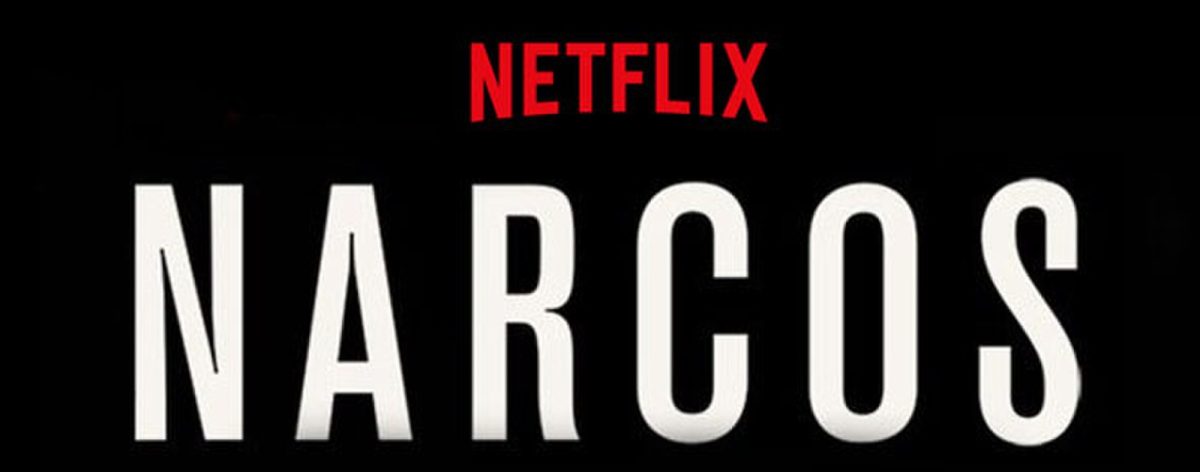
Official logo of the show photo taken from Wikimedia Commons.
Narcos is a Netflix series with three seasons about two drug cartels: the Medellín Cartel and the Cali Cartel. It first focuses on Pablo Escobar and the DEA agents. What’s interesting about the series is how it mixes real historical events with dramatization, using archival material and authentic photographs to give the show a more realistic perspective. Most of the characters represent real people who actually took part in these events, cartel members, their families, DEA agents and also the places where the entire story unfolds.
The performances are outstanding. Wagner Moura, as Pablo Escobar, delivers a chilling and bloodthirsty portrayal. However, the U.S. influence in the way he is portrayed is very noticeable, since they show him almost as a “monster” without nuances. This contrasts with another series from Colombia, called “Pablo Escobar: El Patrón del Mal”, where Andrés Parra plays the same character. Both performances are good, but I think Parra’s is better because, although he shows a criminal who caused the deaths of many innocent people, he also reveals Escobar’s boss-like side, his humor with friends, his infidelities and situations that, although serious, are narrated with more human scenes, even with comedic touches. That allows Escobar to be seen not only as a Hollywood villain, but also as a person with both light and shadow.

The DEA agents, played by Boyd Holbrook (Agent Murphy) and Pedro Pascal (Agent Peña), provide the US perspective on what was happening with the cartels. That helps to understand the complexity of the war on drugs, the fight against the mafia, extradition treaties, the police corruption that covered up crimes and also their own personal struggles. Agent Murphy, for example, deals with difficulties in his marriage, as well as cultural obstacles and language barriers upon arriving in Colombia. Visually, the series contrasts the beauty of landscapes with the harshness of drug violence, creating a portrait that is as appealing as it is disturbing. The use of Spanish reinforces authenticity, with English dialogues spoken in accented voices by Latino characters. For this reason, the best way to enjoy the series is in its original language with subtitles instead of the English dubbing, which dilutes cultural and linguistic nuances and impoverishes the experience. It’s worth remembering that in much of the world we are used to watching subtitled productions, so it shouldn’t be seen as an inconvenience but as a way to approach the work more genuinely.

The aesthetics accurately reflect the Latin American atmosphere of the 90s. Working class neighborhoods and family gatherings are often shown with vibrant colors, full of life and everyday details, while business scenes or meetings between capos adopt more sober tones, dominated by browns and grays. The constant presence of characters smoking or holding a glass of whiskey not only adds realism, but also builds an atmosphere charged with power, tension, and complicity. The series uses nighttime as a dramatic resource, many attacks, murders, and operations take place in the dark or in shadow filled spaces, which heightens the sense of threat and secrecy. This play between light and darkness reflects not only violence but also the duality of a world where partying, death, luxury and misery coexist brutally close together.
The soundtrack is without a doubt one of my favorite aspects of Narcos. While it includes a few English songs , most of it relies on Spanish hits from that era, songs that ordinary people actually listened to, which ground the series in its Latin American setting. The opening sequence deserves special mention because is a seductive ballad paired with photographs of weapons or things related to drug trafficking. It works as a symbol of the story itself, seducing the viewer with this song, while also showing that behind this appeal lies a dark and dangerous world.
Narcos has been criticized for supposedly showing an idealized or romanticized lifestyle. In my opinion, those who say that don’t interpret the message correctly. I grew up in Latin America and saw many programs about these topics ever since I was a child. Yes, it does show how some people join the cartels seeking to escape poverty and achieve a life of luxury. But the series also shows the victims’ side, civilians who are kidnapped or murdered, innocent families who suffer from the crimes of these groups and even the young members themselves who die used as bait by their bosses, often tricked into being recruited with the false promise of someday having the money they so desperately need to survive, as well as a high ranking position in the cartel, a future that will never exist. In that sense, I think the series does not glorify drug trafficking, but rather exposes a reality that sadly coexists within Latin American society like a shadow with those luxuries that are fleeting and that always come at an unbearably high cost in innocent lives.
⭐️⭐️⭐️⭐️⭐️⭐️⭐️⭐️ 8/10